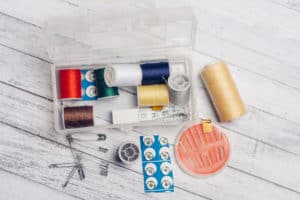If you’re used to sewing everyday objects at home, pillow covers are probably one of the most common and simple projects you can take on. While making a simple pillow cover can be quite easy, adding a zipper to make the pillow more secure inside the pillowcase can be a little trickier.
Learn how to make a pillow cover with a zipper by following the easy steps mentioned in this article. This way you’ll be prepared the next time you have a soft pillow that you want to cover with your favorite fabric and color.
Before Starting

Before you start making your cover, you will need a thread and needle (or a sewing machine), a piece of fabric long enough to cover your pillow, tailoring scissors, a tape measure, a zipper, and some straight pins. There are also some other factors you need to consider before you start sewing.
- Pick out your fabric carefully. While fabrics like cotton are breathable, durable, and easy to wash, other fabrics like velvet and satin look better on decorative pillows. Consider the purpose of your pillow and choose accordingly.
- Try to use a thread that goes with the color of the fabric, even though it will be hidden on the inside.
- Measure your pillow and the fabric. The piece of fabric that you’re using should be one inch larger than the length and width of the pillow. You’ll be using two separate pieces of fabric rather than folding a single, longer piece – so that makes measuring easy.
- The length of your zipper should be equal to or slightly less than the length of your pillow. Make sure to measure along the edge where you plan to put it. You will be squeezing your pillow into the case, so it should not be an issue if the opening is an inch smaller.
How to Make a Pillow Cover with Zippers
Once you have all the materials needed, follow these easy steps to make your pillowcase.

Step 1: Put the two pieces of fabric that you cut out earlier on top of one another. You want the patterned sides of the material facing each other. This is because you will be turning this inside-out once you’re done. Be careful when you’re working with patterned fabrics and make sure that everything is facing the right way.
Step 2: Place your zipper along one edge of the fabric. Use two pins to mark the position of the zipper, but do not pin or sew it in just yet. Once it’s marked, sew from the edge of the pillow to the pin leaving a half-inch gap. You can either sew this by hand or with the help of a sewing machine.
Step 3: Join the area between the two pins with a temporary stitch. Note that this stitch is just to keep the edge in place and is going to be removed later, so do not make it too intricate or tight.
Step 4: Place your zipper face down on this seam and use some pins to keep it in place. Sew it in place from both sides. Using this method ensures that the zipper is inside small flaps and is not glaringly visible when your pillow cover is finished.
Keep the stitching on both sides close to the zipper teeth and work around the zipper slider to get a nice, even stitch. Finish this stitch with a knot or a backstitch to ensure no loose ends or thread pulls.
Step 5: Once the zipper is in place, undo the temporary stitch. Now you can move on to stitching the sides.
Step 6: Put pins on the sides of the remaining edges of the pillow while leaving about a half-inch of space on the side. This will make sure that the pillow cover fits snugly on your pillow and fills it up properly, giving you an even thickness.
Step 7: Stitch the remaining sides of the pillow cover. Make sure you knot up all your stitches while sewing by hand or use backstitches if using a machine.
Step 8: Turn the pillowcase over. You’re done!
FAQs About Pillow Zippers
How do I pick the correct size when it comes to zippers?
Because the pillow cover will be almost the same size as the pillow, it will take a certain amount of strain to make it look good. This pressure will mostly fall on the zipper. Make sure that you get a zipper that is strong but not too wide.
A medium-sized zipper (something that falls halfway between a zipper you would find on trousers and one you would find on a traveling bag) will do the job well. A coil #5 or a vision #5 zipper can be a good fit for both pillows and cushions.
Is there a right size for zipper sliders?
Similar to the zipper, the zipper slider itself should be small enough to hide in the small flaps of the pillow but large enough to easily grab. If you’re ever in a position where you have to look for a replacement slider, try to find one that is as close to the original as possible.
Bottom Line
Making a pillow cover with a zipper closure can be slightly more complicated than sewing a simple pillowcase. However, the finished product will look much more professional and polished.
